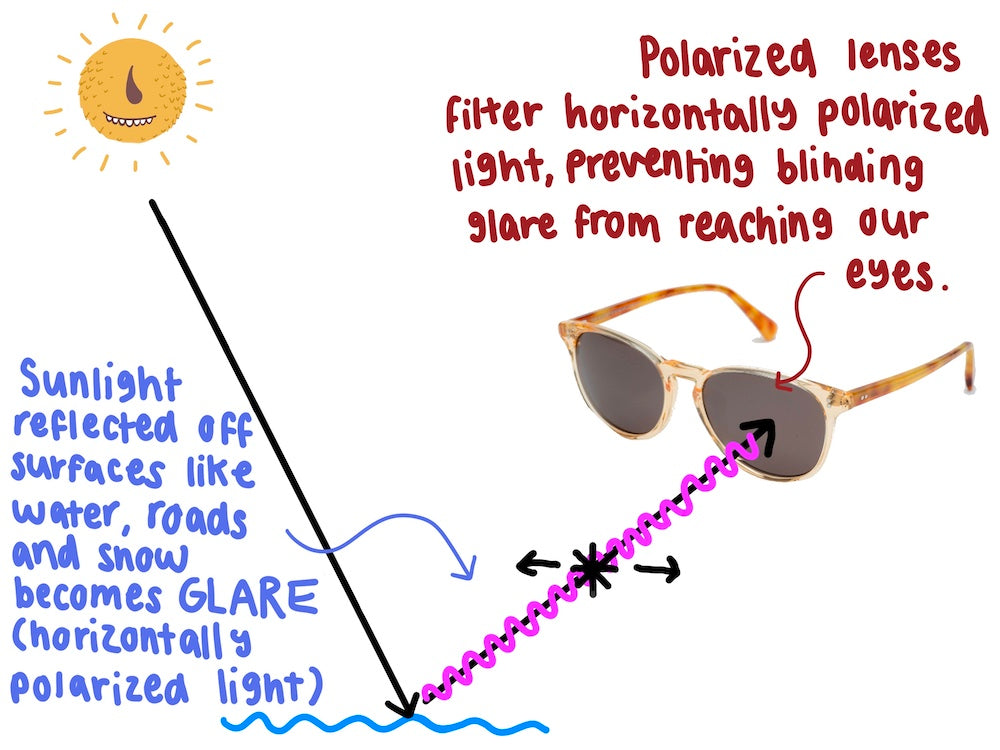What’s the difference between polarized and non-polarized lenses?
Polarized lenses cut glare, while non-polarized lenses allow glare to reach your eyes.
What is glare?
Glare refers to dazzlingly bright horizontally-polarized light reflected off surfaces such as water, roads and snow.
How do polarized lenses work?

Polarized lenses act like a picket fence with vertical slats that cut glare by filtering horizontally-polarized light, or glare, and only allowing vertically-polarized light to reach our eyes, resulting in clearer vision when outdoors.
Are polarized lenses better than non-polarized lenses?
Although both polarized lenses and non-polarized lenses can offer equal levels of UV protection, one could argue that polarized lenses are "better" because they deliver increased visual clarity by cutting glare.
If you're looking for sunglasses with polarized lenses, you can try Rocket Eyewear sunglasses because all our sunglasses come with polarized lenses that cut glare as well as offer 100% protection from UVA/UVB rays.
What are the benefits of polarized lenses?
If you spend a lot of time outdoors doing activities on reflective surfaces such as water, roads or snow, polarized lenses are worth trying because they cut glare and improve visual clarity.
How can you tell if sunglasses are polarized?
The easiest way to tell whether your lenses are polarized is to:
- Place your sunglasses in front of a mobile phone, laptop or tablet device.
- Rotate either your sunglasses or the device 90 degrees.
- See whether the screen (through the lens) looks brighter or darker.
If brightening or darkening happens, your lenses are polarized. If not, your lenses are not polarized.
Darkening happens because screens contain polarizing filters, and if your screen emits horizontally polarized light, your polarized lenses will not let horizontally-polarized light from the screen reach your eyes, resulting in a darkened screen.
If your lenses are polarized, rotating them 90 degrees clockwise or anticlockwise will cause the screen to appear brighter or darker. Brightening can happen because the rotated polarized filters on your sunglasses lens becomes parallel to the screen's polarization filter, allowing horizontally-polarized light to reach your eyes.
What are the disadvantages of polarized lenses?
Polarized lenses can make it hard to see digital screens, such as those on your phone, laptop or tablet device because they are also polarized.
If you need to see a screen for safety reasons, you should not wear polarized lenses because they can hinder your vision. In fact, pilots are not allowed to wear polarized lenses during flight because it would be dangerous if pilots could not read their dashboards!
Why do I sometimes see rainbows in car windows?
Sometimes, when you’re wearing polarized sunglasses, you may see “rainbows” appearing on the side or rear windows of other vehicles.
Don’t worry - there’s nothing wrong with your lenses or your eyes. The rainbows you see are actually strain patterns in the tempered glass windows.
When car side and rear windows are produced, they go through a process called tempering to prevent them from shattering into sharp pieces. During this process, the glass goes through uneven expansion and contraction because the surface of the glass heats and cools at a faster rate than the center of the glass. This type of stress on clear materials, such as glass, produces birefringence, which refracts (redirects) light at many different angles.
When you’re wearing non-polarized lenses, you don’t see a rainbow because your eyes absorb light waves of all angles. However, sunglasses with polarised lenses filter all light waves except vertical ones, allowing you to see the strain patterns in car side and rear windows.
